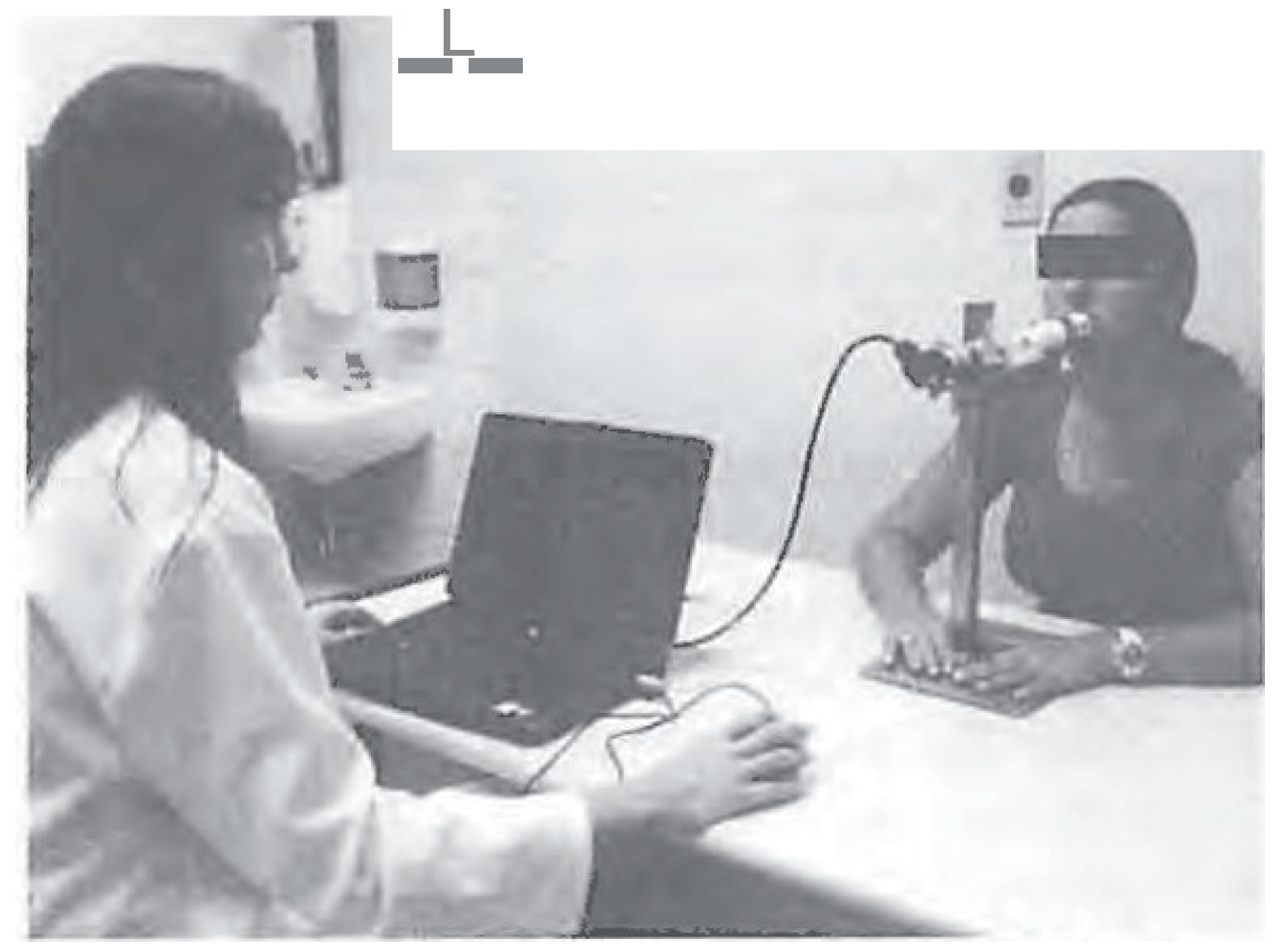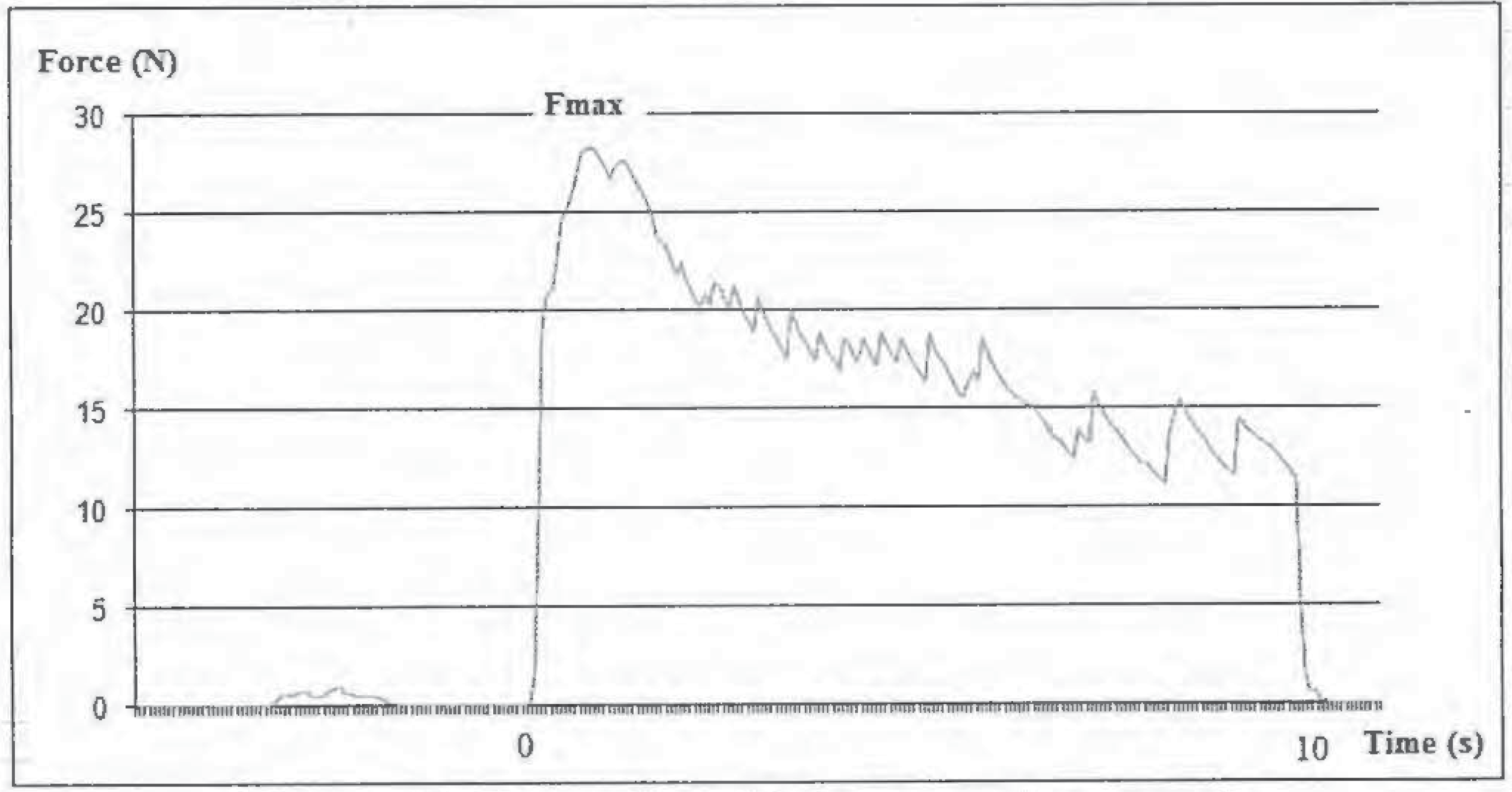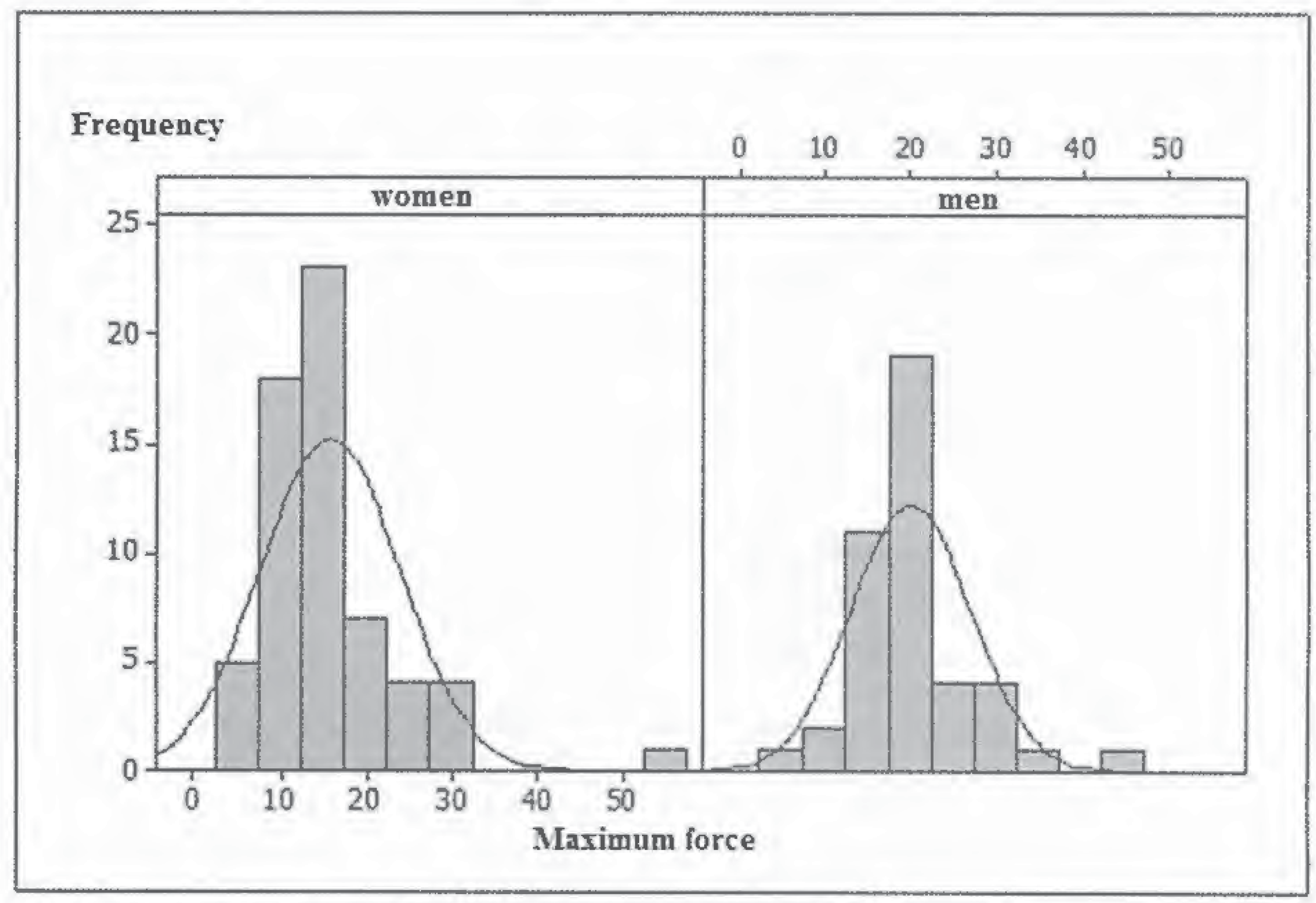Maximum Protrusive Tongue Force in Healthy Young Adults
Abstract
INTRODUCTION
MATERIALS AND METHODS
- Subjects
- Subjective (Qualitative) Evaluation
- Quantitative Evaluation
- Data Analysis
- Statistical Analysis
RESULTS
DISCUSSION
CONCLUSIONS
Acknowledgments
References
- Ball, S., O. Idel, S. Cotton, and A. Perry. 2006. Comparison of two methods for measuring tongue pressure during swallowing in people with head and neck cancer. Dysphagia 21: 28–37. [Google Scholar]
- Barroso, M. F. S., C. G. Costa, J. M. E. Saffar, E. B. Las Casas, A. R. Motta, T. V. C. Perilo, M. C. Batista, and V. G. Brito. 2009. Development of a prototype system for the objective measurement of tongue forces. SBA Controle & Automacao 20, 2: 156–163. (In Portuguese). [Google Scholar]
- Burkhead, L. M., C. M. Sapienza, and J. C. Rosenbek. 2007. Strength-training exercise in dysphagia rehabilitation: Principles, procedures, and directions for future research. Dysphagia 22: 251–265. [Google Scholar]
- Clark, H. M., P. A. Henson, W. D. Barber, J. A. G. Stierwalt, and M. Sherrill. 2003. Relationsh ips among subjective and objective measures of tongue strength and oral phase swallowing impairments. American Journal of Speech-Language Pathology 12: 40–50. [Google Scholar]
- Clark, H. M., and N. P. Solomon. 2012. Age and sex differences in orofacial strength. Dysphagia 27: 2–9. [Google Scholar] [PubMed]
- Dworkin, J. P., A. E. Aronson, and D. W. Mulder. 1980. Tongue force in normals and in dysarthric patients with amyotrophic lateral sclerosis. Journal of Speech and Hearing Research 23, 4: 828–837. [Google Scholar] [PubMed]
- Felicio, C. M. 2009. Edited by C. M. Felicio and L. W. Trawitzki. Desordens temporomandibulares: terapia fonoaudiol6gcia. In Interfaces da Medicina, Odontologia e Fonoaudiologia no complexo cervico-craniofacial. Barueri: Pro-Fono: Vol. 1. [Google Scholar]
- Furlan, R. M. M. M., A. R. Motta, A. F. Valentim, M. F. S. Barroso, C. G. Costa, and E. B. Las Casas. 2013. Protrusive tongue strength in people with severely weak tongues. International Journal of Speech-Language Pathology 1: 1–8. [Google Scholar]
- Furlan, R. M. M. M., A. F. Valentim, T. V. C. Perilo, C. G. Costa, M. F. S. Barroso, E. B. Las Casas, and A. R. Motta. 2010. Quantitative evaluation of tongue protrusion force. International Journal of Orofacial Myology 36: 33–43. [Google Scholar]
- Hewitt, A., J. Hind, S. Kays, M. Nicosia, J. Doyle, W. Tompkins, R. Gangnon, and J. Robbins. 2008. Standardized Instrument for Lingual Pressure Measurement. Dysphagia 23: 16–25. [Google Scholar]
- Hori, K., T. Ono, K. Tamine, J. Kondo, S. Hamanaka, Y. Maeda, J. Dong, and M. Hatsuda. 2009. Newly developed sensor sheet for measuring tongue pressure during swallowing. Journal of Prosthodontic Research 53: 28–32. [Google Scholar]
- Kieser, J., B. Singh, M. Swain, I. Ichim, J. N. Waddell, D. Kennedy, K. Foster, and V. Livingstone. 2008. Measuring intraoral pressure: Adaptation of a dental appliance allows measurement during function. Dysphagia 23: 237–243. [Google Scholar] [PubMed]
- Kydd, W. 1956. Quantitative analyses offorce of the tongue. Journal of Dental Research 35: 171–174. [Google Scholar]
- McAuliffe, M. J., E. C. Ward, B. E. Murdoch, and A. M. Farrell. 2005. A nonspeech investigation of tongue function in Parkinson’s disease. The Journals of Gerontology Series A Biological Sciences and Medical Sciences 60: 667–674. [Google Scholar] [PubMed]
- Mortimore, I. L., P. Fiddes, S. Stephens, and N. J. Douglas. 1999. Tongue protrusion force and fatiguability in male and female subjects. European Respiratory Journal 14: 191–195. [Google Scholar]
- Motta, A. R., J. V. Perim, T. V. C. Perilo, E. B. Las Casas, C. G. Costa, F. E. Magahlaes, and J. M. E. Saffar. 2004. Method for the measurement of axial forces produced by the human tongue. Revista CEFAC 6, 2: 164–169. (In Portuguese). [Google Scholar]
- Pittman, L. J., and E. F. Bailey. 2008. Genioglossus and intrinsic electromyographic activities in impeded and unimpeded protrusion tasks. Journal of Neurophysiology 101: 276–282. [Google Scholar]
- Posen, A. L. 1972. The influence of maximum perioral and tongue force on the incisor teeth. Angle Orthodonicts 42, 4: 285–309. [Google Scholar]
- Robbins, J., R. E. Gangnon, S. M. Theis, S. A. Kays, M. S. Hewitt, and J. A. Hind. 2005. The effects of lingual exercise on swallowing in older adults. Journal of the American Geriatrics Society 53: 1483–1489. [Google Scholar]
- Ruan, W., M. Chen, Z. Gu, Y. Lu, J. Su, and Q. Guo. 2005. Muscular forces exerted on the normal deciduous dentition. Angle Orthodontics 75, 5: 785–790. [Google Scholar]
- Solomon, N. P. 2004. Assessment of tongue weakness and fatigue. International Journal of Orofacial Myology 30: 8–19. [Google Scholar]
- Solomon, N. P., and B. Munson. 2004. The effect of jaw position on measures of tongue strength and endurance. Journal of Speech and Language Hearing Research 47: 584–594. [Google Scholar]
- Solomon, N. P., H. M. Clark, M. J. Makashay, and L. A. Newman. 2008. Assessment of orofacial strength in patients with dysarthria. Journal of Medical Speech-Language Pathology 16, 4: 251–258. [Google Scholar] [PubMed]
- Stierwalt, J. A. G., and S. R. Youmans. 2007. Tongue measures in individuals with normal and impaired swallowing. American Journal of Speech-Language Pathology 16, 2: 148–156. [Google Scholar]
- Trawitzki, L. V., C. G. Borges, L. O. Giglio, and J. B. Silva. 2011. Tongue strength of healthy young adults. Journal of Oral Rehabilitation 38: 482–486. [Google Scholar] [PubMed]
- Utanohara, Y., R. Hayashi, M. Yoshikawa, M. Yoshida, K. Tsuga, and Y. Akagawa. 2008. Standard values of maximum tongue pressure taken using newly developed disposable tongue pressure measurement device. Dysphagia 23: 286–290. [Google Scholar]
- Yoshida, M., T. Kikutani, K. Tsuga, Y. Utanohara, R. Hayashi, and Y. Akagawa. 2006. Decreased tongue pressure reflects symptom of dysphagia. Dysphagia 21: 61–65. [Google Scholar]



| Groups | Average (N) | Median (N) | SD | Minimum (N) | Maximum (N) | Pearson’s Variation Coefficient |
|---|---|---|---|---|---|---|
| Male and Female | 17.58 | 16.23 | 7.95 | 5.84 | 57.18 | 45% |
| Female | 15.79 | 14.51 | 8.13 | 5.84 | 57.18 | 51% |
| Male | 20.16 | 19.93 | 7.01 | 5.84 | 42.80 | 35% |
| Trial | Average (N) | Median (N) | SD |
|---|---|---|---|
| Trial 1 | 19.78 | 18.02 | 8.52 |
| Trial 2 | 16.57 | 15.65 | 7.86 |
| Trial 3 | 16.38 | 14.85 | 8.15 |
© 2014 by the author. 2014 Monalise Costa Batista Berbert, Vívian Garro Brito, Renata Maria Moreira Moraes Furlan, Tatiana Vargas De Castro Perilo, Amanda Freitas Valentim, Márcio Falcão Santos Barroso, Estevam Barbosa De Las Casas, Andréa Rodrigues Motta
Share and Cite
Berbert, M.C.B.; Brito, V.G.; Furlan, R.M.M.M.; de Castro Perilo, T.V.; Valentim, A.F.; Barroso, M.F.S.; de Las Casas, E.B.; Motta, A.R. Maximum Protrusive Tongue Force in Healthy Young Adults. Int. J. Orofac. Myol. Myofunct. Ther. 2014, 40, 56-63. https://doi.org/10.52010/ijom.2014.40.1.5
Berbert MCB, Brito VG, Furlan RMMM, de Castro Perilo TV, Valentim AF, Barroso MFS, de Las Casas EB, Motta AR. Maximum Protrusive Tongue Force in Healthy Young Adults. International Journal of Orofacial Myology and Myofunctional Therapy. 2014; 40(1):56-63. https://doi.org/10.52010/ijom.2014.40.1.5
Chicago/Turabian StyleBerbert, Monalise Costa Batista, Vivian Garro Brito, Renata Maria Moreira Moraes Furlan, Tatiana Vargas de Castro Perilo, Amanda Freitas Valentim, Marcio Falcao Santos Barroso, Estevam Barbosa de Las Casas, and Andréa Rodrigues Motta. 2014. "Maximum Protrusive Tongue Force in Healthy Young Adults" International Journal of Orofacial Myology and Myofunctional Therapy 40, no. 1: 56-63. https://doi.org/10.52010/ijom.2014.40.1.5
APA StyleBerbert, M. C. B., Brito, V. G., Furlan, R. M. M. M., de Castro Perilo, T. V., Valentim, A. F., Barroso, M. F. S., de Las Casas, E. B., & Motta, A. R. (2014). Maximum Protrusive Tongue Force in Healthy Young Adults. International Journal of Orofacial Myology and Myofunctional Therapy, 40(1), 56-63. https://doi.org/10.52010/ijom.2014.40.1.5




